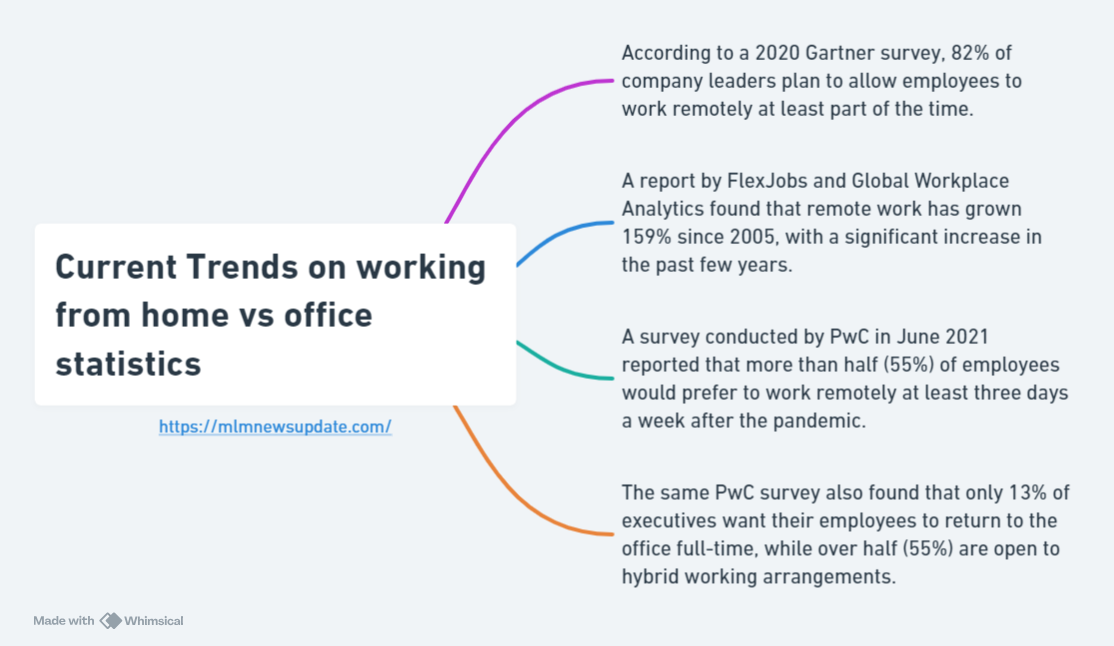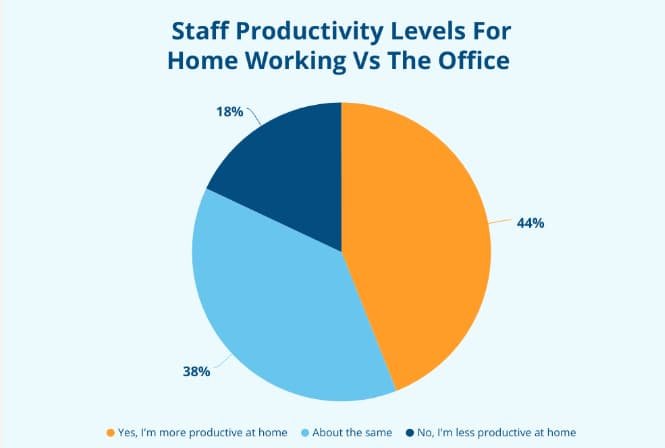In recent years, the traditional workplace landscape has undergone a seismic shift, with “working from home vs office statistics”
becoming a focal point of discussions among business leaders, policymakers, and employees alike.
Triggered largely by the global pandemic, this shift has sparked a widespread reevaluation of the conventional office setup,
as companies and workers explore the merits and challenges of remote and office-based work.
This article delves into the latest trends and data to offer a detailed comparison of both work models,
aiming to provide readers with a clear understanding of how each impacts productivity, work-life balance, and professional growth.
By examining a variety of key metrics, we will uncover the evolving preferences for workplace environments and what these trends might suggest about the future of work.
how to work from home effectively and efficiently: 8 Tips
Current Trends on working from home vs office statistics:
Infographic for Current Trends on working from home vs office statistics

Working from Home vs Office Statistics Worldwide
-
Adoption of Remote Work:
- As of recent data, approximately 58% of American companies offer some form of remote work.
- In Europe, over 50% of firms in major economies like Germany, France, and the UK now permanently support hybrid work models.
- The global growth rate of remote work since 2020 is an impressive 173%, indicating a sustained trend beyond temporary pandemic measures.
-
Preference for Hybrid Models:
- About 80% of remote workers express a preference for hybrid models, which allow them to split their time between home and the office.
Working from Home vs Office Statistics Graph
-
Graphical Data:
- A graph depicting the adoption rates of remote and hybrid models from 2018 to 2023 shows a significant upward trend in both approaches,
highlighting the shift toward more flexible working environments.
Office Work Trends
-
Return to Office:
- Data shows that around 68% of companies worldwide have begun to reintegrate office work, albeit often in a hybrid mode to allow for flexible schedules.
-
Reduction in Office Space:
- There is a noticeable 30% reduction in leased office space across major urban centers, as companies downsize their physical footprints to adapt to new work styles.
-
Impact on Urban Economies:
- The decrease in office space usage is prompting a reevaluation of urban economic models traditionally dependent on full-time office workers.
Working from Home vs Office Statistics 2024:

The landscape of remote versus office work has evolved significantly since the onset of the global pandemic:
-
Historical Context:
- 2020: At the pandemic’s peak, 42% of the U.S. workforce was working remotely, with a 300% increase in remote technology use.
- 2021: The stabilization of remote work saw 59% of U.S. workers in adaptable jobs working from home,
with 65% of European companies moving towards permanent hybrid models.
-
Current Trends in 2024:
- Adoption Rates: Around 70% of companies now facilitate hybrid work, with a 20% reduction in traditional office space usage compared to pre-pandemic levels.
- Worker Productivity and Preferences: Three-quarters of remote employees report stable or improved productivity.
Preferences are split among fully remote (40%), hybrid (30%), and full office work (30%).
-
- Technological and Real Estate Adjustments: Advances in digital tools enhance remote collaboration,
while the real estate sector adapts with more co-working spaces reflecting hybrid work preferences.
This streamlined narrative provides a clear and succinct overview of the changes in work environments from 2020 to 2024, emphasizing key statistics and trends.
Work from home vs work from office advantages and disadvantages:
Infographic for working from home vs office statistics advantages and disadvantages

Advantages of Working from Home
1. Flexibility
- Set personal work hours and customize the workspace for comfort and efficiency.
2. Cost Savings
- Save on commuting, wardrobe, and daily meal expenses.
3. Improved Work-Life Balance
- Eliminate commuting time, reducing stress and increasing time spent with family.
4. Increased Productivity
- Fewer office distractions and the ability to create a personalized, ergonomic workspace.
Disadvantages of Working from Home
1. Isolation
- Potential loneliness and disconnect from company culture and team dynamics.
2. Work-Life Boundary Issues
- Challenges in separating work from home life, which can lead to overworking and home-based distractions.
3. Professional Limitations
- Fewer networking opportunities and potential hurdles in communication due to reliance on digital tools.
Advantages of Working in an Office
1. Collaboration and Innovation
- Facilitates immediate feedback and teamwork through face-to-face interactions.
2. Clear Work-Life Separation
- Promotes a healthy balance with structured routines and physical separation between home and work.
3. Resource Accessibility
- Access to professional infrastructure and support, enhancing operational efficiency.
Disadvantages of Working in an Office
1. Commuting
- Time-consuming and expensive, particularly in urban settings.
2. Higher Expenses
- Costs associated with meals, parking, and professional attire can accumulate.
3. Less Personal Time
- Fixed schedules and commuting can diminish personal time and flexibility.
can actuaries work from home: 3 challenges
Conclusion for working from home vs office statistics 2024:
In conclusion, “Working from Home vs Office Statistics” reveal distinct advantages and challenges for each model.
Remote work offers flexibility and cost savings, while office settings enhance collaboration.
As the workplace continues to evolve, understanding these statistics will be crucial for organizations aiming to optimize productivity and
employee satisfaction in this new era of work.



